Menu
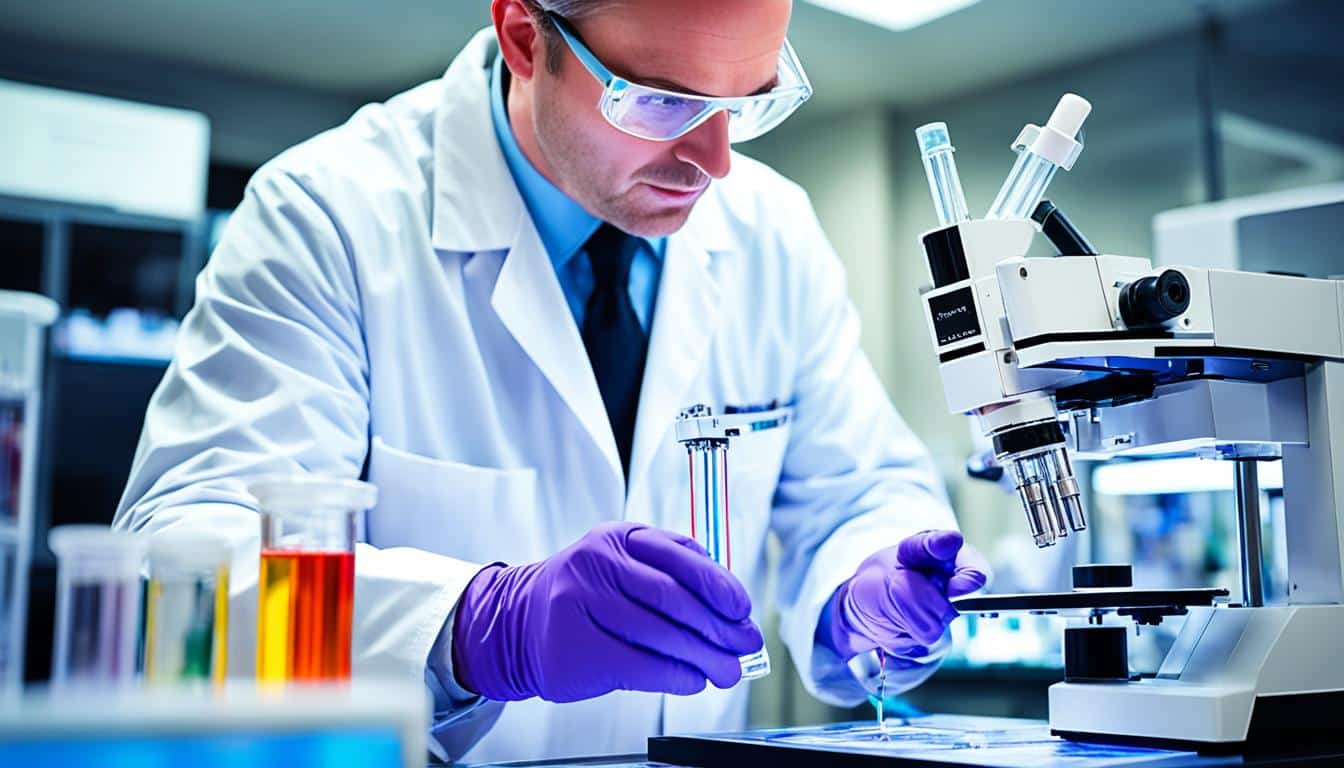
Biotechnology may seem new, but its roots go back thousands of years. However, the term itself is only about a century old. The field is like a toolbox filled with tiny ‘machines’ that can change life’s foundation. Today, these tools are solving big problems. They’re making medicine more precise, helping crops grow better, and cleaning up the environment.
Biotechnology is changing the game in many areas. In health, it’s making treatments that fit just one person by looking at their genes. Farming is using special crops that need fewer chemicals. These crops grow more and can handle tough weather. Plus, they’re working towards making things like fuel and plastics without hurting the planet.
Biotechnology blends biology, chemistry, and engineering. It changes living things or their parts to create new products. This area tackles global issues and leads in making new things in many fields.
Biotechnology includes areas like *genetic engineering breakthroughs*, *synthetic biology*, and *bioinformatics advancements*. In farming, biotech crops are huge. The majority of crops like corn and soybeans in the U.S. have biotech roots. They are safe for food, showing biotechnology’s value in farming.
Synthetic biology and *genetic engineering breakthroughs* are key in biotechnology. Techniques like fermentation and *bioinformatics advancements* help in making new things. For example, fermentation makes producing antibiotics and vaccines easier. Genetic engineering helps plants clean up pollution and makes soil better.
Biotechnology joins experts from many areas to make great strides. Mixing synthetic biology with *bioinformatics advancements* leads to big achievements. In health, biotechnology is making sickle cell treatments common by 2024. Personalised medicine, using new drugs like bi-specific antibodies, is growing.
Biotechnology keeps getting better, helping farming, health, and industry. It will keep shaping the future, solving big problems, and boosting our world.
Biotechnology is changing healthcare by making it more precise and personal. It uses new findings in genetics and immunotherapy. This lets us create treatments that are just right for each person. It helps make treatments better and cuts down on unwanted effects.
In modern medicine, genomic sequencing is a game-changer. We can now do nearly 1,000 tests to find out about diseases or risks. This technology helps create treatments that match a person’s unique genes. It means treating illnesses more directly with less side effects.
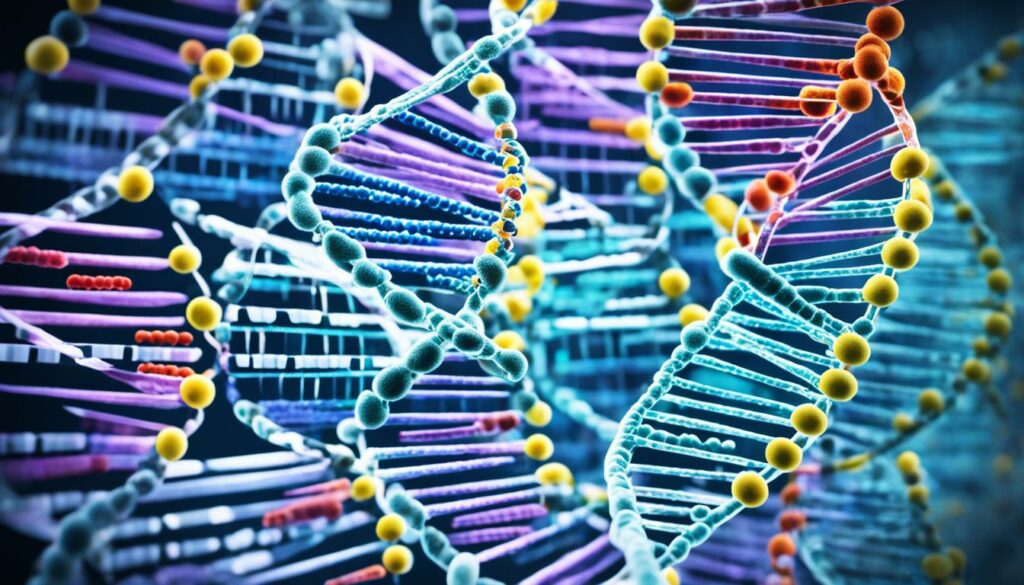
Thanks to biotechnology, diagnostic tests are faster and cheaper now. For instance, a simple blood test can now check your cholesterol. This shows how much this field has advanced.
Gene editing, like with CRISPR Cas9, has opened new doors in healthcare. It can fix genetic issues at the root. In China, Gendicine was the first approved gene therapy for cancer. It treats squamous cell carcinoma using a special cancer-fighting gene.
Cell therapy is also becoming more important. It’s particularly helpful for diseases like type 1 diabetes. Studies show that after getting new pancreatic cells, 80% of patients didn’t need insulin after a year.
Immunotherapy is a big deal in fighting cancer and other illnesses. It boosts the body’s defences against diseases. In the U.S., more than 40 biotech drugs have been approved. They help with conditions like cancer, cystic fibrosis, and hepatitis. These treatments push forward in personal and targeted medicine.
Looking ahead, biotechnology will keep bringing new health solutions. With better gene editing and immune therapies in the future, things look hopeful. Plus, exploring in nature could bring new health breakthroughs. For example, scientists are looking at ticks for blood thinner and poison frogs for pain relief.
| Aspect | Example | Impact |
|---|---|---|
| Genomic Sequencing | 1,000 genetic tests available | Early disease detection and personalised treatments |
| Gene Editing | CRISPR Cas9 | Precise modifications to treat genetic disorders |
| Cell Therapy | Pancreatic cell transplants for diabetes | Reduced dependency on insulin injections |
| Immunotherapy | FDA-approved treatments for multiple diseases | Enhanced immune response for cancer therapy |
In short, biotechnology is making big steps in health through genomics, gene editing, and immune treatments. These improvements bring more effective and personal care.
Biotechnological advancements have changed farming for the better. They have led to the creation of genetically modified crops. These crops can survive pests and tough environmental conditions. This has boosted crop yields and their ability to grow well.
In 2012, most crops in the U.S. were genetically modified. Specifically, 88% of corn, 94% of cotton, and 93% of soybeans. These crops can handle pests and diseases without needing as many harmful pesticides. As a result, farming is more productive and profitable, producing better crops.
Precision agriculture uses technology to farm more efficiently. It keeps an eye on conditions in the fields. This allows farmers to use water, fertiliser, and pesticides more wisely. Crop farming becomes more sustainable, reducing waste and its impact on the environment.
As the world’s population grows, biotechnology keeps our food supply stable. It has made crops like herbicide-tolerant soybeans, cotton, and corn. These crops allow farmers to use less harmful herbicides. Genetic engineering has also helped fight off plant diseases. For example, it saved the U.S. papaya industry from a virus. These advancements in agricultural biotech are vital for our food security against various challenges.
Biotechnology provides new ways to clean up and protect our environment. It tackles big problems like pollution and not-so-green practices. This science uses tiny living things to dissolve harmful pollutants. It’s an earth-friendly way to solve problems, aiming to drop the use of bad chemicals.

Bioremediation is a key part of environmental science. It uses living things to make places cleaner. For instance, in Nigeria’s Niger Delta, oil pollution is a major issue. Here, techniques like biopile technology are used to clean up. This process mixes dirty soil with helpful stuff to break down pollutants. It’s also used in the US and Europe. Seeing this work shows how much power eco-friendly ways have.
Making biofuels is very important for our energy needs and for our planet. Biotechnology has made it possible to produce these fuels in a much greener way. One important part is trapping carbon dioxide. This helps lower the greenhouse gases that cause global warming. Using biofuels moves us in a good direction for a liveable future.
Being kind to the planet means using things that do less harm. That’s where biodegradable materials come in. Combining biology with materials lets us create items that break down easily. This cuts down on trash and helps save our natural world. The latest in biotechnology, such as tiny enzymes and tech, is making these green products.
Industrial biotechnology uses microorganisms and enzymes for sustainable production. It merges various biotech technologies for better and cleaner production. This leads to more eco-friendly ways of making things.
Industrial biotech aims to replace harmful chemical methods with greener ways. By using biocatalysts, it cuts down on pollution and saves energy. This shift helps reduce the carbon footprint from making goods.
The core of industrial biotechnology is biocatalysts and microbial fermentation. These processes turn raw materials into useful bio-products without much waste. They also use resources that can renew, making production more sustainable.
Biotech is boosting the growth of bio-products like bioplastics and biofuels. These are eco-friendly compared to petrochemical options. They cut down on fossil fuel use and greenhouse gas emissions.
The Advances in Industrial Biotechnology journal explores various topics in the field. It’s widely available through Google Scholar and J-Gate. The U.S. bio-based market has been a significant economic driver, making over 2.2% of GDP in 2012.
As the world focuses more on sustainable development, industrial biotech is becoming key. It will have a big part in the new, green economy.
| Year | Market Value (in billion $) | Contribution to GDP (in %) |
|---|---|---|
| 2012 | 353 | 2.2 |
| 2016 | 78 | 5.4 |
| 2025 (estimated) | 100 | – |
Industrial biotechnology is a growing field that focuses on green and profitable solutions. It uses the power of microbes and enzymes in smart ways to benefit the planet and the economy.
In today’s world, personalised healthcare is changing fast. New treatments and precision medicine lead the way. These help doctors offer treatments that fit each patient better, improving results and meeting their unique needs.
At the heart of personalised medicine is customised treatment. The cost of reading our genes has dropped, thanks to Illumina’s NovaSeq X and NovaSeq X Plus. These machines can read 20,000 genomes a year, much more than the old limit of 7,500. This means doctors can use our gene details to plan treatments that work best for us.
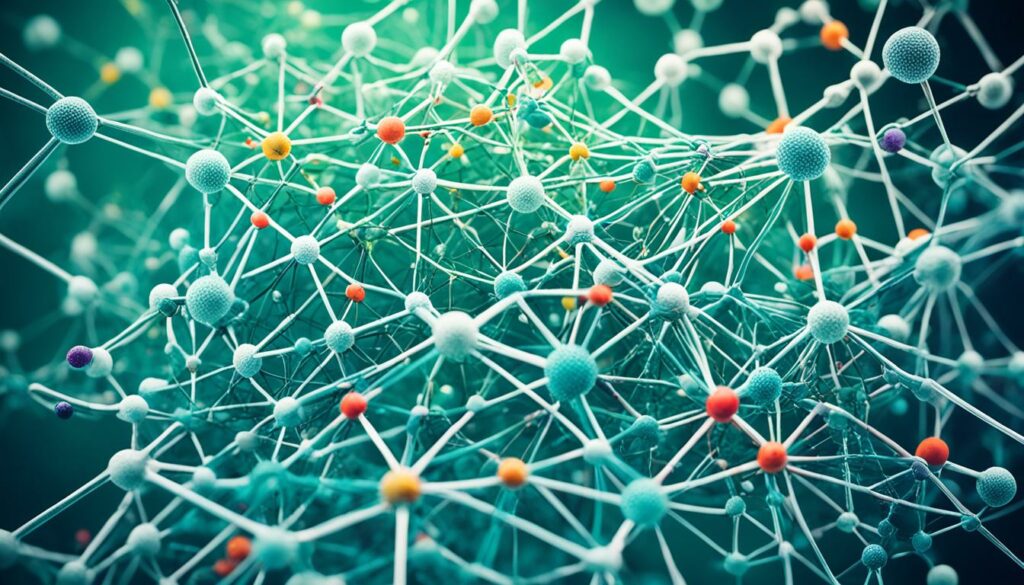
Targeted therapies are vital in personalised healthcare. They aim treatments at the exact spots that need help. A good example is Herceptin. It targets the HER2 to help fight breast cancer. Newer treatments, like CRISPR for sickle cell disease, show the exciting progress we’re making.
This customised, precise way of treating patients boosts success and cuts down on costs. Research experts think the market for gene sequencing could hit $27.8 billion by 2028. More people want treatments that are made just for them, and tech keeps getting better.
In the end, customised care and precise medicine are changing healthcare for the better. With new tech and treatments, we’re getting closer to truly personalised healthcare for everyone. This is a big step for healthcare, making sure each patient gets the best, focused care.
The field of biotechnology has seen major changes recently. The CRISPR Cas9 technology is a key example. It has improved our gene editing abilities by a huge margin. Now, researchers can work more precisely with the genetic code. This is crucial in fighting genetic diseases and making agriculture better.
CRISPR Cas9 is very accurate at editing genes. It uses CRISPR nucleases, with Cas9 being the main one. These ‘scissors’ cut DNA exactly where we want. It works well in animal cells, like T cells, without needing special mice setups. We can aim at any part of the DNA very precisely. This has been hard to do before now.
We have ways to use CRISPR/Cas9 in human and mouse T cells effectively. This makes the research quicker and more likely to help people. The system can remove genes or correct them, helping with genetic problems.
CRISPR Cas9 is very useful in health and farming. In health, it opens new doors to treat tough diseases. Scientists are finding ways to use it for precision medicine. This includes fighting cancer in a smarter way. There is also the potential to learn more about how our immune system works.
In farming, CRISPR/Cas9 helps make better crops. This is good for fighting hunger and working with nature better. By improving crops, we help to feed more people and do it in a way that’s good for the planet.
CRISPU Cas9 is becoming more and more important. It’s changing how we see health, farming, and more. This technology marks a big step forward in biotechnology. It shows us what is possible in improving life and the environment.
The ELISA technique is key in diagnostic biotechnology. It’s vital for spotting proteins in biological samples. This makes it great for diagnosing diseases, tracking treatments, and creating custom medicine.

ELISA uses antibodies and enzymes to find specific proteins. It involves an antigen-antibody reaction. This leads to a colour change or a fluorescent signal. ELISA is very good at precisely diagnosing diseases because of this.
| Technology | Application | Benefits |
|---|---|---|
| Real-Time PCR | Detecting SARS-CoV-2 Variants | High Sensitivity and Speed |
| Multiplex Real-Time PCR | Respiratory Virus Detection | Comprehensive Viral Panel Analysis |
| Digital PCR | Quantifying Pathogens like Borrelia Burgdorferi | High Precision in Low Abundance Detection |
| Triplex Digital PCR | Measuring Intact Proviral HIV-1 DNA | Accurate Quantification of Viral Load |
ELISA is widely used in medicine where protein detection is key. It helps in finding infectious diseases, checking immune status, and tracking autoimmune conditions. With ELISA, we can focus on specific pathogens and markers, leading to big steps in diagnosis.
Recently, adding AI to ELISA has changed the game. Now, machine learning makes assays better, improves conditions, and checks quality in real time. This mix is propelling diagnostics forward with better accuracy, speed, and growth.
Next-Generation Sequencing (NGS) has changed how we see DNA and RNA. It lets us look at genes in more detail and faster than before. This approach has been in the spotlight for almost ten years. It has made a big difference in medical studies by showing us more about genes.
When we say ‘next-generation sequencing’, we talk about new methods. These methods can quickly read a lot of genetic information. They can read anything from small bits to very large amounts of genetic code.
Techniques for reading genes have really sped up. Illumina’s machines, for example, can read lots of genetic code very quickly. They can handle anything from 300 kilobases to many terabases in one go. The latest NovaSeq X series can even manage up to 16 terabases.
These big leaps help customised medicine. They mean doctors can treat people more precisely. This could help patients live longer, better lives. It could also make healthcare more cost-effective.
There are also clever tools that help prepare gene readings and keep their data organised. These tools make the whole gene-reading process smoother and reduce mistakes.
NGS is widely used to look at all sorts of genetic information. For example, it helps find and study viruses like SARS-CoV-2. It’s key in tracking how diseases spread, studying cases of multiple infections, and seeing how viruses change over time.
This technology opens doors for new medicine and treatments. Studies by Goodwin et al. (2016) and Levy et al. (2016) show just how powerful NGS is. It’s changing the way we do research in big ways.
Metzker (2005) and Logsdon et al. (2020) have highlighted the progress of NGS. Additionally, Salk et al. (2018) have proved how NGS can find very rare genetic changes. This shows its importance in today’s research.
| Technology | Data Output | Applications |
|---|---|---|
| Illumina NovaSeq X | Up to 16 Tb | Comprehensive genomic research, personalised medicine |
| Rapid Library Preparation | Varies | Streamlined NGS processes |
| LIMS Integration | Enhances Workflow | Efficient sample and data management |
The world of venture-backed biotech firms is fast-paced and always changing. Recently, leaders in the field have seen big shifts in where money comes from. Although there was less money raised in 2022, the use of venture debt has grown. This has helped biotech companies keep going without needing new investors right away.
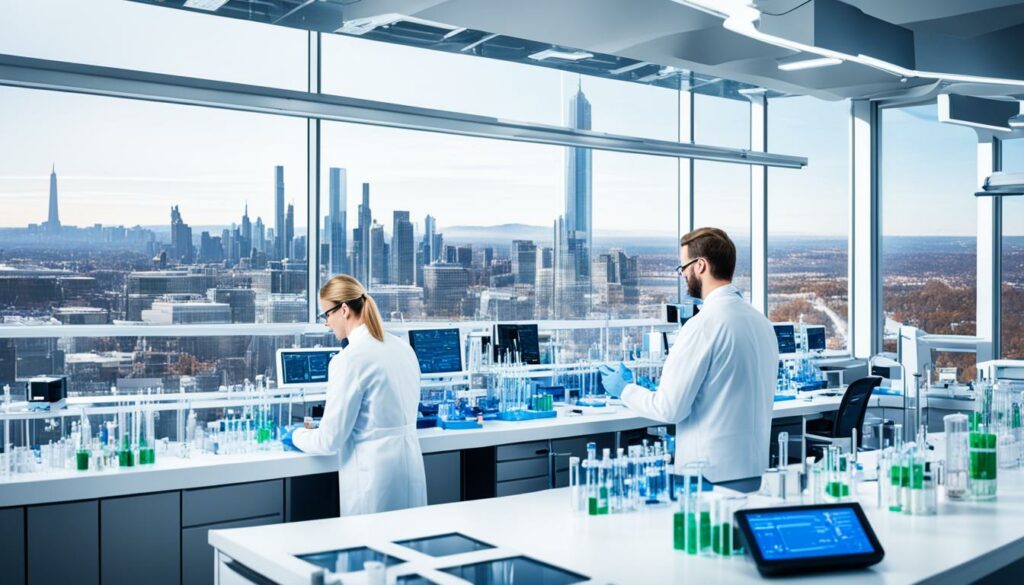
Many venture-backed biotech firms are leading in game-changing technology. Companies like Editas Medicine, focusing on CRISPR Cas9, are turning heads. Their work could change how we edit genes. Others, like Illumina with Next-Generation Sequencing (NGS), are advancing genomic science. Now, more than ever, venture funding is key to driving innovation and growth in biotech.
Investing in biotech has led to big wins for the industry. Take AI in drug discovery, for example, which has attracted over $9 billion. These stories show how tech can speed up research. Also, the biotech hotspot isn’t just the USA; Europe is strong, too, even if prices are better in America.
| Year | IPO Count | Capital Raised |
|---|---|---|
| 2021 | 114 | $16.0 billion |
| 2023 (Q1-Q3) | 30 | $3.4 billion |
Being smart and original in biotech is key to getting big investors’ attention. Investors like projects that are not too risky and are far in their development. Even though it’s getting harder to go public or get private funding, biotech firms are finding new ways. This includes being bought by big pharma or making smart alliances to get needed cash.
The S&P Biotechnology Select Industry Index’s drop at the end of 2023 was steep. It was a hard time for jobs as many people got laid off. However, venture capital is strong, with start-ups getting a lot of money in 2022 and even more in 2023. Cell therapy and regenerative medicine areas are especially hot, drawing in lots of money for new biotech projects.
Biotechnology is leading new strides in renewable energy, especially in biofuel development. Between 2000 and 2007, global biofuel production tripled. However, biofuels made up only 1.6% of transportation fuel by 2012. Sustainable biotech is key to growing this sector and reducing our reliance on fossil fuels.
Biofuels are proving they can stand on their own economically. In 2014, ethanol hit $40.9 billion, and biodiesel reached $3.8 billion. Although bio-methane’s income was lower at $0.019 billion, its environmental benefits are crucial. New biotech solutions aim to make these technologies more efficient and cost-effective. They include using synthetic biology to lower production costs and enhance biofuel production sustainability.
Finding renewable ways to replace fossil fuels has become a pressing need. Biotechnology is crucial in this shift, providing innovative solutions in the biotech sector. Between 20–40% of methane in oil and gas comes from microorganisms, hinting at more energy recovery from older sites. The $173 billion-value biofuel industry aims to reduce reliance on fossil fuels. But, relying on fossil fuels can lead to economic challenges. It can cause corruption, income gaps, and even international issues. Biotech helps move towards cleaner, more fair energy, showing its importance in creating a sustainable future.
Bioinformatics is key in modern scientific study, merging data with biology to make strides. This mix leads to breakthroughs in genomics and proteomics.
Bioinformatics changed how we research and use vast data. It lets us analyse DNA, RNA, and epigenetics deeply. This helps understand health and disease better through data.

With genomics and proteomics, bioinformatics is crucial. It finds how genetic differences impact drugs and their effects. This helps improve gene therapy and advances synthetic biology.
It also helps make medicine personal by looking at how genes metabolise drugs. This leads to better treatments for individuals.
Massive Bioinformatics is leading in this field. They focus on next-gen sequencing, including COVID-19 research. Their work is key for healthcare and research, all while respecting privacy and rules.
Biotechnology and neuroscience have teamed up to find new ways to treat brain conditions. They’ve changed how we look at and deal with diseases like Alzheimer’s and Parkinson’s. This mix of tech and biology has opened up exciting new possibilities.
Biotechnology is paving the way for fresh ways to tackle brain diseases like Alzheimer’s and Parkinson’s. Doctors and researchers are finding new solutions by digging into our genes and how they affect our health. This approach helps target the very roots of these issues.
Take CRISPR-based gene editing, for example. It can fix the bits of our DNA that cause certain illnesses. Also, changing the balance of bacteria in our gut could be a breakthrough. It might mean personal treatments for things like epilepsy and depression.
Stem cells are at the heart of some major advances in helping the body to heal itself. They can turn into different kinds of cells, offering hope for people with serious nerve damage or diseases. This research is a big step forward in medicine.
Now, thanks to 3D bioprinting, we can make structures that fit specific patient needs. This is a huge leap in customising medicine for each person. It shows the growing role of technology in healthcare.
Collaborations between top labs, like the Lawrence Berkeley National Laboratory and Macquarie University, are making these strides possible. Joining hands across different fields is speeding up progress. It’s pushing us nearer to new solutions for brain disorders.
| Institution | Innovation | Application |
|---|---|---|
| State University of New York | New strain of E. coli for PHA copolymers | Material science, biodegradable materials |
| University of Western Cape | Patented biodegradable biosurfactants | Environmental sustainability |
| Google and Harvard | Mapped human brain equivalent to a 1-millionth section | Neuroscience, computational biology |
San Francisco is a leader in biotechnology with over 100 top firms. These companies lead in scientific breakthroughs and new technologies. This makes the area a top choice for biotech innovation.
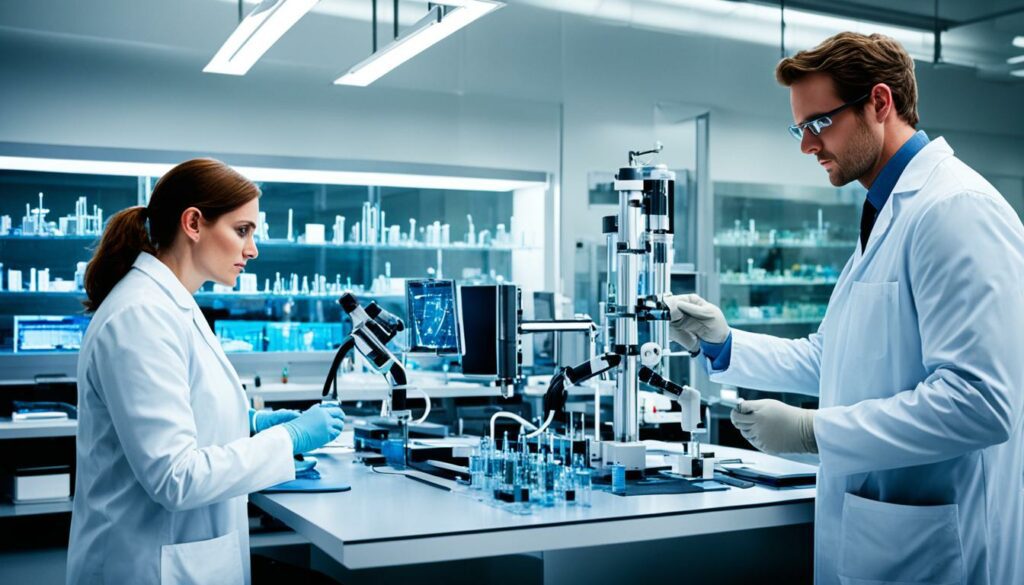
Genentech and others drive innovation. Genentech started in 1978 and made synthetic human insulin. This work decreased reliance on animals and the risk of allergies. It showed San Francisco’s potential for big innovations. Companies like Scispot are also pushing boundaries, improving lab work.
Advances in San Francisco’s biotech range from genomics to AI in medicine. They use AI, robotics, and CRISPR-Cas to change healthcare. Medicine is getting more exact and effective thanks to these advances.
“San Francisco’s biotech landscape is revolutionising healthcare with a strong emphasis on precision, efficiency, and personalisation, transforming the way we approach medicine.” – Industry expert
Biotechnology’s growth brings key challenges and ethical issues. Safety is crucial, as is a strong regulatory system. This helps keep the public safe and guides biotechnology’s development.
The heart of biotech challenges and ethics lies in the design of clinical trials. A notable case is Gelsinger in 1999. This tragic event showed the need for strict rules in testing. It is vital to protect human volunteers and ensure tests are reliable.
Biotech’s healthcare costs can be high. Some treatments cost over $20,000 a year. This raises questions about who can afford these treatments. It also highlights issues of access to healthcare.
Protecting intellectual property in biotech is challenging. It’s important to protect innovations without blocking access to them. With the human genome’s discovery, privacy over health data has become a big issue. This data can affect jobs, insurance, and getting a mortgage. So, it’s vital to balance protecting and sharing this information.
We must find fair ways to share the benefits of biotechnology worldwide. This means ensuring fairness and access in technological progress.
| Challenge | Details & Implications |
|---|---|
| Ethical Design of Clinical Trials | Protecting human subjects, ensuring clear test results. Example: Gelsinger case. |
| Cost of Biotech Healthcare | Expensive biologics ($20,000/year+), ethical debates on affordability and equity. |
| Privacy Concerns | Decoding human genome, implications for jobs, insurance, mortgages. |
| Intellectual Property | Balance between protection of innovations and equitable access. |
| Access to Biotech Innovations | Fair distribution of benefits, addressing global disparities. |
Solving these issues requires focusing on ethical governance. It’s about addressing public safety while honouring ethical standards. Creating this balanced environment lets everyone enjoy the safe benefits of biotech.
Looking ahead, the next 5-10 years in biotechnology will be hugely groundbreaking. We will experience growth in size, range, and speed of new biotech products. As gene synthesis and sequencing costs drop, and design tools become more available, we will see new, diverse biotech innovations.
New biotech products, due to advanced genetic engineering like CRISPR, could be very different or somewhat similar to what we have now. This shows why teams from different fields must work together. They need to handle both the great chances and hard issues that come with changing genes. As products get more complex, we’ll need fresh ways to check their risks, since we can’t compare most of them to older products.
There are some issues with current biotech rules. They can sometimes miss new, risky products. This might shake people’s trust in how we regulate biotech. For a safe and trusted biotech future, we must govern it with strong ethics and clear rules. The European Union, through the EFSA and the European Commission, sets a good example. They make decisions based on solid science when it comes to GMOs.
Getting the best from biotechnology means we also solve its hardest problems. It’s up to us to push for responsible innovation. This way, we can overcome the many challenges in this fast-moving sector.
Recent advancements in biotechnology include key discoveries in gene editing. CRISPR Cas9 allows precise edits in genes. Next-gen sequencing tools and personalised medicine strategies are also on the rise.
It improves sustainable farming through enhanced crops. These include genetically modified plants that grow better and fight off pests. By making farming more efficient, it supports the challenge of feeding a growing global population.
Biotechnology helps protect the environment through bioremediation. This method uses tiny organisms to clean up pollution. It also advances in green energy and recyclable products, which limits harmful waste.
Biotechnology is changing the game in healthcare. It’s making personalised medicine and precise treatments possible. Tools like CRISPR Cas9 are tackling genetic diseases. And treatments like immunotherapy are reshaping cancer care.
ELISA is key for spotting proteins in health tests. It plays a big part in diagnosing diseases and keeping track of treatments. By highlighting key markers, it’s helping tailor medicine to each patient.
NGS is a game-changer in studying genes and their activity. It’s fast and accurate, shining new light on genetic differences. This helps in finding new drugs, making personalised treatments, and tackling complex illnesses.
San Francisco is a top spot for biotech due to its leading role in health and disease studies. It’s home to top actors in therapeutics, diagnostics, and now AI health tech. This focus makes it a hotspot for big biotech strides.
The field grapples with keeping the public safe and fairly sharing tech advances. It also tackles who owns these innovations and the rules governing them. Ways must be found to guard these values while pushing progress.
It plays a big role by creating green energy sources. Through biofuels and earth-friendly materials, it lessens our need for harmful fossil fuels. This work aims for a greener, more sustainable future.
Bioinformatics is the backbone of biotech, using data to shape genetic and protein studies. The mix of computer analysis and biology gives powerful new insights. This drives forward new medical options and scientific understanding.